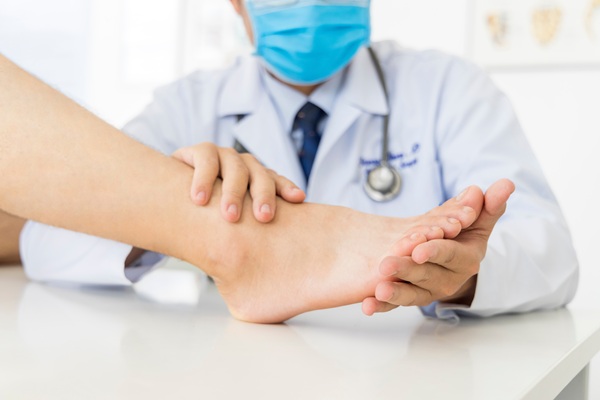Myofascial ReleaseAustell, GA
Myofascial release is a specialized therapy offered by orthopedic professionals to alleviate pain, improve mobility, and release tension in the connective tissue surrounding muscles. This hands-on technique targets tightness and stiffness, promoting overall musculoskeletal health and restoring functionality.
Delta Orthopedics in Austell and the surrounding area offers myofascia release therepy. Call 678-439-5216 to schedule an appointment today.
What is Myofascial Release?
Also known as trigger point therapy, myofascial release is a non-invasive treatment performed by an orthopedic doctor or PA-C to address pain and restricted movement caused by tight fascia. Fascia is the connective tissue surrounding and supporting muscles, bones, and organs. When it becomes tightened or more rigid, it can lead to pain and loss of motion that can affect quality of life.
During a myofascial release session, gentle sustained pressure is applied to the affected areas, targeting specific points of tension. This technique promotes increased blood flow, relieves pain, and enhances the tissue's flexibility. It is often used to treat conditions such as chronic pain, muscle stiffness, and post-injury recovery.
“When it becomes tightened or more rigid, it can lead to pain and loss of motion that can affect quality of life.”
Reasons to Seek This Treatment
There are many reasons individuals may seek myofascial release treatment. Identifying these symptoms early and seeking treatment can prevent further complications and enhance the patient’s overall quality of life.
Chronic Pain
Fascial restrictions can lead to chronic pain that does not respond to other treatments. Myofascial release helps to gently release these restrictions, reducing pain and improving overall mobility by targeting the root cause of the pain rather than just the symptoms.
Post-Surgical Recovery
Surgical scar tissue can form and restrict movement, causing discomfort and stiffness. Myofascial release helps to soften and break down scar tissue, allowing for better healing and improved flexibility. This treatment can also increase blood flow to the affected area, promoting recovery and reducing the risk of long-term restrictions.
Injury Rehabilitation
Sports injuries, accidents, or muscle strain often cause tension or restrictions in the fascia, limiting movement. This therapy focuses on relieving this tension, which can speed up recovery and restore normal function.
Limited Mobility
Fascial tightness can make it difficult to move muscles and joints freely, leading to stiffness and discomfort. Myofascial release improves flexibility by releasing restrictions in the fascia, making movement easier and more comfortable, enhancing one’s range of motion and overall physical performance over time.
Stress-Related Tension
Myofascial release provides a gentle and effective way to reduce stress-induced tension, promoting relaxation. Relieving fascial restrictions helps calm the nervous system and allows the body to release built-up stress.
“Myofascial release improves flexibility by releasing restrictions in the fascia, making movement easier and more comfortable, enhancing one’s range of motion and overall physical performance over time.”
Benefits of Myofascial Release
Pain relief is one of the leading benefits of myofascial release. Additional benefits of therapy include:
- Improved Flexibility. Restores range of motion and allows for easier movement.
- Enhanced Recovery. Speeds up recovery from injuries by improving blood flow and tissue repair.
- Stress Relief. Reduces muscle tightness caused by stress and enhances relaxation.
- Personalized Treatment. Orthopedic specialists tailor each session to the patient’s unique needs, ensuring optimal results.
These advantages make myofascial release an effective treatment for patients seeking non-surgical pain relief and improved mobility.
“Orthopedic specialists tailor each session to the patient’s unique needs, ensuring optimal results.”
The Myofascial Release Process
The myofascial release process begins with a consultation with an orthopedic doctor or PA-C. The specialist will assess the patient’s range of motion, identify areas of tightness, and discuss the symptoms affecting their daily life. Our team will base the treatment plan on this assessment and other factors.
Sessions are delivered in a series and typically last between 30 to 60 minutes, depending on the severity of the condition and the areas being treated. During the treatment, the provider uses their hands to apply consistent, gentle pressure to areas called trigger points in the fascia, areas that feel stiff instead of elastic and movable. The goal is to release tension, promote blood circulation, and restore the tissue's natural elasticity. Patients may feel mild discomfort during the procedure, especially in areas of significant tightness. However, this is a sign that the therapy is working to release restrictions and improve tissue health.
“The goal is to release tension, promote blood circulation, and restore the tissue’s natural elasticity.”
After Care for Myofascial Release
After a myofascial release session, patients are encouraged to take steps that support their recovery and maintain the treatment’s effects. Along with lifestyle adjustments such as posture maintenance and avoiding repetitive motion strain, patients should incorporate light stretching into their routine to maintain flexibility and reduce tension. Hydration becomes especially important as drinking plenty of water helps flush out toxins released during therapy.
Follow-up appointments are key, and regular sessions may be recommended based on the patient’s condition and recovery progress. During these follow-up appointments, patients should communicate any persistent discomfort. Additionally, they should express any other concerns to their orthopedic specialist to ensure the best possible outcomes.
“Hydration becomes especially important as drinking plenty of water helps flush out toxins released during therapy.”
Questions Answered on This Page
Q. What does myofascial release therapy treat?
Reclaim Your Mobility with Myofascial Release
Find relief from pain and tension with myofascial release. Schedule your consultation with Jose Marti, PA-C and the Delta Orthopedics team today by calling 678-439-5216 and take the first step toward improved mobility and comfort.
Frequently Asked Questions
Q. What conditions can myofascial release treat?
A. Myofascial release can treat chronic pain caused by tight fascia in several areas, including the neck, back, hips, feet, arms, and shoulders caused by tight fascia. It may also benefit individuals with limited mobility due to fascial restrictions and those recovering from injuries or surgery. Stress-induced muscle tension is another common condition that myofascial release addresses, helping to relieve tightness and improve relaxation.
Q. How long does a session last?
A. Most myofascial release sessions last between 30 and 60 minutes, depending on the patient’s needs and treatment goals. During the session, the therapist focuses on specific areas of tightness or pain to provide effective relief. Your therapist will tailor the session length to best support your recovery and well-being.
Q. Is myofascial release painful?
A. While myofascial release is generally gentle, patients may experience mild discomfort in areas with tight or restricted fascia. This discomfort can be a sign that the therapy is helping to release tension. The therapist works within the patient’s comfort level, ensuring the pressure applied is effective but not overwhelming. Over time, as restrictions ease, the sensation becomes less intense, and many patients find the process relaxing.
Q. How many sessions will I need?
A. The number of sessions required varies based on the severity of the condition and the patient’s response to treatment. Some patients notice improvement after just one or two sessions, while others may need several weeks of therapy. Your therapist will evaluate your progress and adjust the treatment plan to ensure optimal results.
Q. What should I do after a session?
A. After a myofascial release session, it is important to stay hydrated to support your body’s natural healing processes. Gentle stretching can help maintain the improvements in flexibility and range of motion achieved during the session. Following any specific advice from your therapist, such as posture corrections or lifestyle adjustments, will enhance the results.
Definitions
- Fascia
- Connective tissue surrounding and supporting muscles and organs.
- Chronic Pain
- Persistent pain lasting for an extended period, often due to underlying conditions.
- Range of Motion
- The extent of movement a joint or muscle can achieve.
- Injury Rehabilitation
- The process of restoring function and mobility after an injury.
- Scar Tissue
- Fibrous tissue that forms during the healing process after surgery or injury.
- Post-Surgical Recovery
- The phase of healing and rehabilitation following surgery.
- Orthopedic Care
- Medical care focused on the musculoskeletal system.
- Blood Circulation
- The movement of blood throughout the body, delivering oxygen and nutrients.
- Gentle Pressure
- A technique used in myofascial release to alleviate tension.
- Stress Relief
- Reduction of muscle tension caused by stress.
Contact Us
Delta Orthopedics is located at
1790 Mulkey Rd Build 9 Suite 1314
Austell, GA 30106





